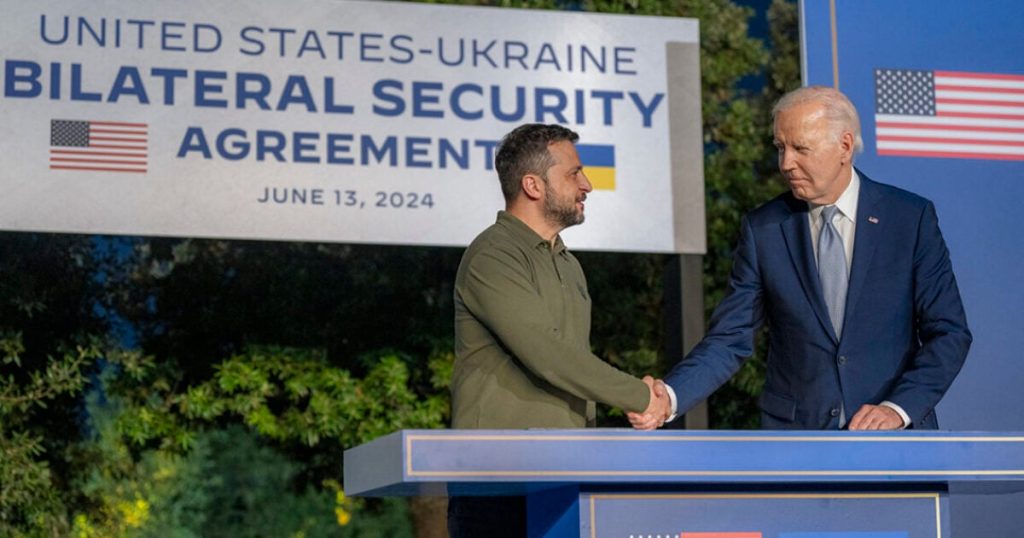Photo courtesy of US Embassy, Italy, June 13, 2024
By signing the new Bilateral Security Agreement between the United States and Ukraine, Joe Biden has added Ukraine to the long list of countries whose defense the US is obligated to support.
While the agreement is technically bilateral, the specific benefits to the US remain unclear. Unlike NATO’s Article 5, this agreement does not include mutual defense commitments. However, the act of signing it has significantly increased the likelihood of conflict with Russia.
Additionally, the agreement will impose costs on US taxpayers in the short, medium, and long term, and could potentially cost American lives in the not-so-distant future.
The United States and Ukraine signed a 10-year bilateral security agreement on June 13, 2024, during the Group of Seven (G7) summit in Italy. This agreement aims to solidify long-term defense and security cooperation between the two nations.
According to U.S. National Security Adviser Jake Sullivan, the agreement sends a clear message of resolve to Russia, indicating that the coalition supporting Ukraine remains strong. The pact includes provisions to enhance Ukraine’s defense capabilities and ensure continued U.S. assistance, funded by U.S. taxpayers, in addressing Ukraine’s security needs well into the future.
While the agreement focuses on various aspects such as training Ukraine’s armed forces, enhancing intelligence sharing, and developing military capabilities, it does not include specific monetary pledges.
However, in conjunction with this agreement, the G7 leaders have backed a $50 billion loan package to support Ukraine’s broader economic and defense needs. This financial support is separate from the $60 billion in aid that the US has already approved for Ukraine.
The agreement is not a step toward NATO membership and does not commit US or NATO forces to direct military involvement in the ongoing war with Russia. Consequently, the White House can claim that it does not increase the risk of escalation.
However, Russia has predictably reacted negatively, condemning the signing of the agreement and viewing it as a direct threat and a provocative act that challenges its strategic interests in the region.
The Kremlin has warned that such moves could lead to further tensions and instability, cautioning that any miscalculations could lead to unintended escalations.
Just days later, North Korea and Russia intensified their partnership against the West by signing a mutual defense pact, signaling a significant augmentation in their military cooperation.
This agreement primarily facilitates the exchange of conventional weapons, ammunition, and potentially advanced military technology from Russia to North Korea.
In return, North Korea provides Russia with much-needed ammunition for its ongoing conflict in Ukraine, highlighting a pragmatic and mutually beneficial relationship between the two nations.
The formalized alliance between Russia and North Korea, combined with the US-Ukraine defense agreement, further complicates the Ukraine war and dramatically increases the chances of triggering a global conflict, potentially involving an axis of Russia, North Korea, and China.
China and North Korea already have the Sino-North Korean Mutual Aid and Cooperation Friendship Treaty, signed on July 11, 1961. This treaty is a mutual defense pact that obligates the two countries to defend one another militarily in the event of an attack, similar to the mutual defense obligations found in Article 5 of NATO.
The treaty also includes provisions for economic cooperation and consultation on major international issues, reinforcing the strategic and military alliance between China and North Korea. Additionally, China and Russia maintain a “no limits” partnership. This web of alliances dramatically increases the chance of escalation in the Ukraine War, while solidifying the formation of an anti-Western bloc.
The benefits Ukraine receives from the US-Ukraine defense agreement are tangible, including direct military aid, training for its armed forces, and economic support that strengthens its defense capabilities and stabilizes its economy.
In contrast, the benefits the US receives are intangible, including enhanced geopolitical stability in Eastern Europe, deterrence of further Russian aggression, valuable intelligence on Russian military tactics, reinforced alliances with NATO and other partners, and support for international norms regarding sovereignty and territorial integrity.
However, the costs to the US are very concrete, involving tens of billions of dollars in the long run and the potential for a massive loss of life in a war with China, Russia, and North Korea.
The post New US-Ukraine Bilateral Security Agreement: A Path to Escalation and Burden on American Taxpayers appeared first on The Gateway Pundit.






